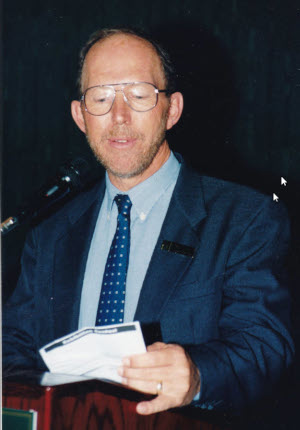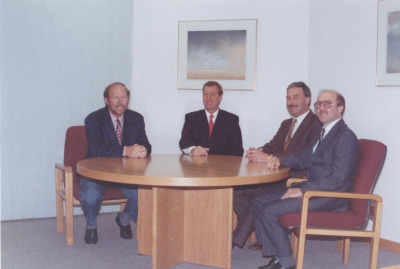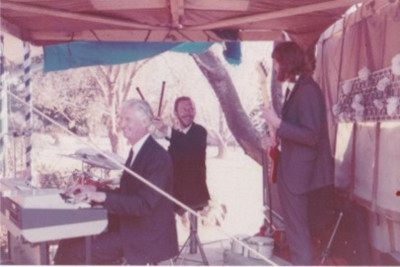Trevor Strugnell
SABC
1970 to 1971
Trevor was one of the unfortunate SABC technical employees who never got the chance to transition from the Radio division to the newly formed Television division. The SABC technical division did not allow employees working for the radio services to apply for jobs in the television services as they were concerned allowing the migration would impact the radio services.
In addition to Trevor's technical accomplishments he was a skilled musician who also performed at concerts with the SABC Symphony Orchestra.
Brian Horn (SABC)
Technical Career

After completing my military service, I enrolled for the electronics course at the Wits Technical College. I chose to do 2 years full time at college followed by 2 years practical. During this time, I became
interested in television as I heard it was coming to South Africa. Two classmates at technical college, Gunter Bekker and George van Gils would later play a part in my career in television. I chose to do my
practical at the SABC, joining on the July 1971 as a Senior Technician working in the maintenance workshop. Giel van Zyl was in charge, next in line was At Lensing and our workshop manager was a Mr. Trapps.
Apart from servicing and repairing electronic equipment such as turntables, audio recorders and mixing desks we also had to look after the Radio Highveld Automat which was a bank of computer controlled Revox
audio recorders which played music, time announcements, jingles, and ads for 24 hours a day. Once an hour it switched to a sound studio where a news reader would deliver the latest news bulletin. The team I
worked with (technical and operators) included Neil Allen, Pierre Joubert, Trevor Evans, Ottan Gabler, Gaby Kaiser, Frans Jordaan.
When the announcement was made that South Africa was to introduce television, most of us in the technical department requested a transfer to the television department. Our applications were turned down, so I
resigned from the SABC in August 1972.
I joined Intelec Flight Electronics where I enjoyed the challenge of avionics and was issued with a Radio Technicians Certificate by the Postmaster-General. This qualified me to “undertake the routine maintenance and repair of radio apparatus upon which the safety of life at sea and in the air depends”.
When Communication Consultants took over Interlec in 1974 they shut down the Flight Electronics company and offered me a technical post in Communication Consultants. Intelec’s senior Television Engineer Ken Kershaw told me about what they were doing for HITV (Holiday Inn TV) in Lesotho, Botswana and Swaziland. More importantly he informed me that they had been awarded two contracts for SABC television. These were to supply IVC 1” Video Tape Recorders (VTR’s) to be used for the test transmissions and Barco color monitors for the Television Center. Dennis Hinstridge, Graham Shaw, Tom Cook and Ken Kershaw all left the company following the takeover which left Communication Consultants with a dilemma in that they had contracts to supply SABC and no one knew anything about television. It was an opportunity to get into television.
I was sent to IVC in Reading in the UK 3 months and to Barco in Belgium for a month to learn all about IVC VTR’s and Barco color monitors. On delivery of IVC VTR’s and Barco monitors to SABC they had to first go through acceptance testing. This was where I met Brian Horn, Theunis Nel, Fred Cluley, and Peter Eklund. I was seconded to the SABC VTR section for 3 months to nurse the IVC 901 VTR’s through the test transmission phase. There were many challenges with the technology of those days as everything was analog and was subject to drifting.
Although I had learned about IVC VTR’s and Barco monitors and read Television Servicing by G. N. Patchett, from front to back there was a lot I did not know about broadcast Television. I personally owe a lot to Brian Horn who would very patiently and precisely explain concepts like Differential Phase and Gain to us during the acceptance testing sessions. That taught me the finer points of television and drummed specifications into my head which I will never forget, like the subcarrier frequency is 4,43361875MHz +-1Hz!
A strange problem arose with all the Barco color monitors, the convergence of either red or blue would not align to spec at the very top of the monitor. This had never been experienced anywhere else by Barco, so they sent Rik Joye to SA to investigate. It turned out that the error was due to the monitor being in the Southern Hemisphere and our earth’s magnetic influence was different to that in the factory in Belgium. Many days were spent modifying the monitors until they all passed the acceptance testing.
While I was seconded to the SABC I met Chris Pretorius. In September 1975 we attended a course on the IVC 2001 Digital TBC in Reading which was developed by Micro Consultants Limited of Newbury which was the first digital television product to be developed in the industry. Micro Consultants Limited became Quantel, a name derived from Quantised Television.

In 1988 Frans Kruger, Chris Pretorius and I wanted to break away from Communication Consultants and offered to buy out the Television Division from the owners, the Venters. An offer was made which was initially accepted in principle by Hennie Venter. This was subsequently vetoed by Liz Venter who wanted more money than it was worth. Frans and Chris left Communication Consultants at the end of 1988 to start Questek and I joined them in February 1989.
The agencies that were transferred from Communication Consultants to Questek were:
- Audio Developments
- Avitel
- Barco
- Dynair
- For-A
- Philip Drake Electronics
- Quantel
- Softel
- Systems Video
Other projects I worked on at Communication Consultants included:
- HITV (Holiday Inn TV) The facilities in Johannesburg and at the Holiday Inns were upgraded to color, a necessatity with the introduction of the color SABC TV service.
- Turfontein and Greyville Race Courses The race courses in Johannesburg and Durban were equipped with IVC color VTR's and cameras.
- SA Defense Force TV Studio A television studio was designed and built at the College of Educational Technology (Colet). Communication Consultants were awarded a contract to provide technical support, I was seconded to them for this purpose.
- SA Defense Force Outside Broadcast Vehicle Communication Consultants were awarded a contract to design, build, equip and run a 3 camera color outside broadcast vehicle for Colet. The project team responsible for the project consisted of Frans Kruger, Chris Pretorius, Phil Kroll and I. It was the first OB van ever to be built and operated in South Africa. It was equipped with IVC 7000P portable color cameras, IVC 961P VTR, Barco monitors, and a range of ancillary equipment. We had a problem finding a suitable vision mixer due to the sanctions so some of our experienced good friends at the SABC designed and built a local vision mixer.
- SWABC TV System (now Namibia Broadcasting Corporation) Communication Consultants were appointed to design, install and commission their initial TV broadcast system which started broadcasting in October 1981. An empty warehouse was converted into a TV station.
- SWABC Outside Broadcast Vehicle In 1982 we compiled a tender for an OB van on behalf of SWABC, as consultants we could not bid for the contract. Ampex happened to have a ready-built 3-camera OB, this cut down the delivery time and the contract was awarded to them.
Daily the SABC would fly tapes recorded from the night before to Windhoek. These would be edited with SWABC logos and news readers to localize them for broadcast that night in Windhoek, their news was always a day late. The SWABC broadcasts were recorded in Windhoek and flown the following day to Oshakati to be broadcast in northern Namibia.
 Musical Career
Musical CareerMy musical career started when I was attending Parktown Boys High School where I was a side drummer in the school cadet band. The cadet band was always in the SA finals losing only to Pretoria Boys High. I also started taking drumming lessons from Johnny Maritz who was the chief percussionist for the SABC Symphony Orchestra.
When I was drafted to do compulsory army training, I was sent to the Army Gymnasium in Heidelberg. While at the gymnasium I was informed that they had been given the go ahead to start an army band at the gymnasium. They knew I was a drummer as I had taken my drum kit to the base to play together with a brilliant organist, Glynn van Straaten (who later gained fame as Glynn Storm). I spent the rest of 1968 as the leading drummer of the Army Gymnasium band. We were only allowed to play music for half the day and so the other half of each day was filled by turning us into instructors for Vehicle Maintenance, Light Machine Guns, Drill Instructors, Signals among others. I particularly enjoyed working on the radios and during this time made up my mind what I wanted to do following army training. I wanted to become an electronics technician.
When Johnny Maritz found out that I was an SABC employee at Broadcast Centre, where the SABC Symphony Orchestra was housed, he seized the opportunity when the orchestra required additional percussionists and roped me in for rehearsals. Mr Trapps would call me and let me know that I was required for rehearsal in Studio 1. I would rehearse with them and then go on to perform the concerts which were normally in the City Hall.